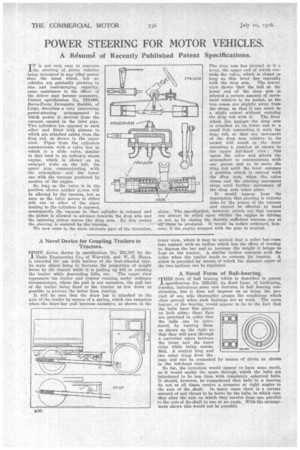POWER STEERING FOR MOTOR VEHICLES.
Page 110

If you've noticed an error in this article please click here to report it so we can fix it.
A 114sum4 of Recently Published Patent Specifications.
TT is not very easy to conceive -I-the steering of motor vehicles being entrusted to any Other power than the hand wheel, but ac vehicles are gradually growing in size and load-carrying capacity, some assistance to the effort of the driver may beCome necessary. Patent specification No. 276,006, Servo-Frein, Dewandre Societe, of Liege, describes a very interesting power-steering arrangement in which power is derived from the vacuum caused in the inlet pipe. Two cylinders are opposed to each other and fitted with pistons to which are attached cables from the drag rod, as shown in the upper view. Pipes from the cylinders communicate with a valve box in which is a slide valve, -similar to that used in an ordinary steam engine, which is .shown on an enlarged scale on the left, the upper pipe communicating with the atmosphere and the lower one with the vacuum produced by suction of the engine.
So long as the valve is in the position shown neither ploton will be effected by the vacuum, but so S001.1 as the valve moves to either side one or other of the pipes leading to the cylinders is exposed, consequently the vacuum in that cylinder is reduced the piston is allowed to advance towards the drop arm the opposing piston moves the drop arm. By this means the steering is assisted by the-vacufma.
We now come to the more intricate part of the invention. and and • 2d The drop arm has pivoted to it a lever, the upper end of which controls the valve, which is closed so long as this lever lies centrally with the drop arm. The lowest view shows that the. ball at the lower end of the drop arm is allowed a certain amount of movement relative to its socket, as the two cones are slightly away from the stops, so that it can move to a slight extent without carrying
the drag rod with .it. The lever which lies against the drop arm is attached at its lower end to a small link connecting it with the drag rod, so -that any movement of the drop arm relative to its socket will result in the lever assuming a position as shown in the upper left-hand view ;. this opens the valve and allows the atmosphere to communicate with one piston and so to move the drag rod until the lever assumes a position which is central with the dfop arm, when the valve closes and the steering movement stops until further movement of the drop arm takes place.
It would appear from the description that steering is entirely done by the action of the vacuum and cannot he effected by hand alone. The specification, however, points out that vacuum " can always be relied upon whther the engine be driving or not, as by closing the throttle sufficient vacuum can at sill-times be produced. It would be rather awkward, however, if the engine stopped with the gear in neutral.












































































































































































